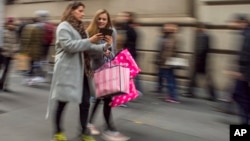U.S. consumer spending rose at only a sluggish pace in January, even as signs of growing optimism about the economy have emerged.
Consumer spending increased 0.2 percent in January, after a 0.5 percent gain in December, the Commerce Department said Wednesday. Spending on services — from haircuts to health care — was flat, and Americans spent less on long-lasting goods such as autos and appliances.
Prices also rose in a sign that inflation has perked up a bit. A measure of inflation closely watched by the Federal Reserve rose 0.4 percent in January and has increased 1.9 percent in the past 12 months. That's the biggest year-over-year gain in more than four years.
That nearly matches the Fed's target of 2 percent and may make a rate hike by the Fed more likely this year.
Surveys of consumers have shown a burst of optimism since the presidential election, yet that has only intermittently translated into more spending. The Conference Board's consumer confidence index jumped to a 15-year high in February after a modest dip in the previous month.
Measures of consumer health are important for growth because consumer spending drives about 70 percent of economic activity.
Income growth accelerated slightly in January, the data showed, rising 0.4 percent. That was slightly better than the previous two months.
Wednesday's figures suggest that the economy is still growing at a modest pace. Growth was just 1.9 percent at an annual pace in the final three months of last year, the government said Tuesday. That was sharply lower than the 3.5 percent increase in the third quarter.
Rising inflation may hinder spending in the coming months. Adjusted for taxes and price increases, Americans' incomes actually slipped 0.2 percent in January, the largest decline in more than three years.








